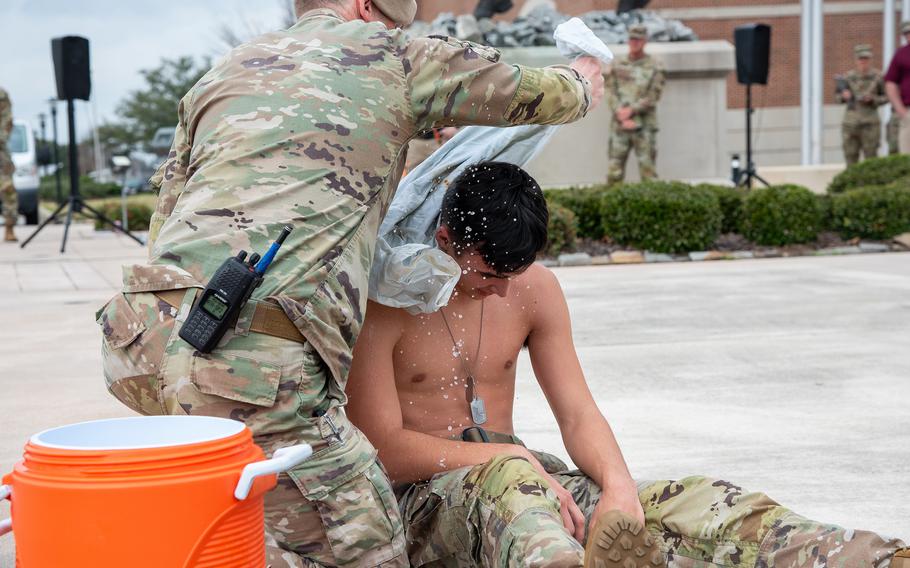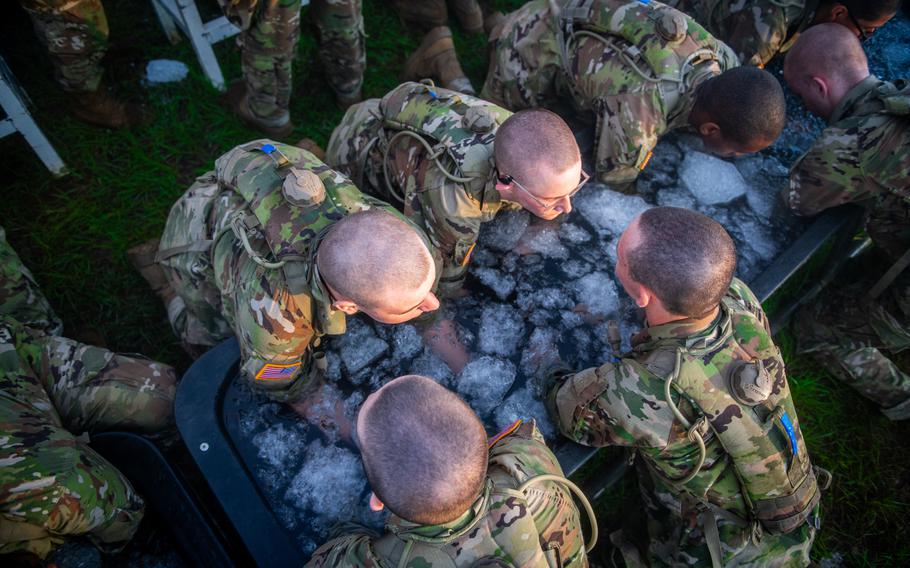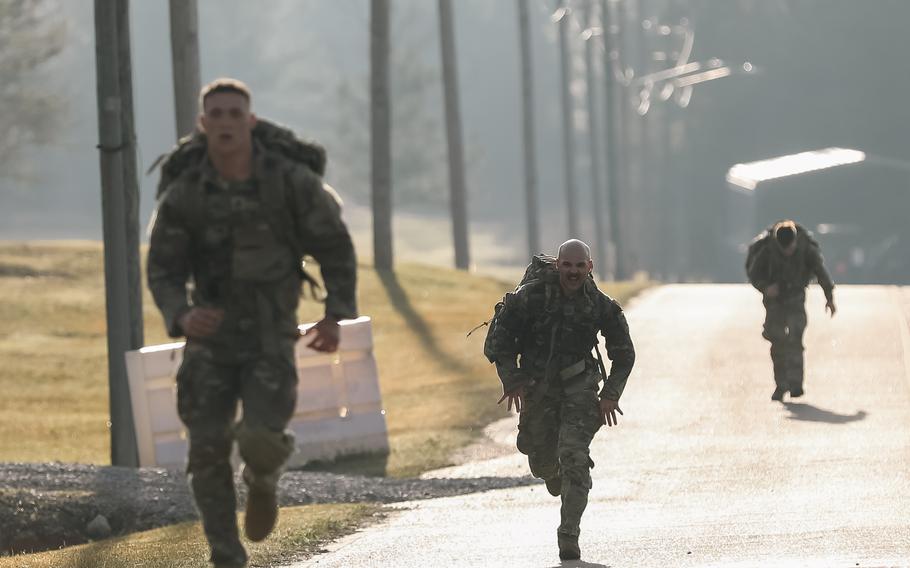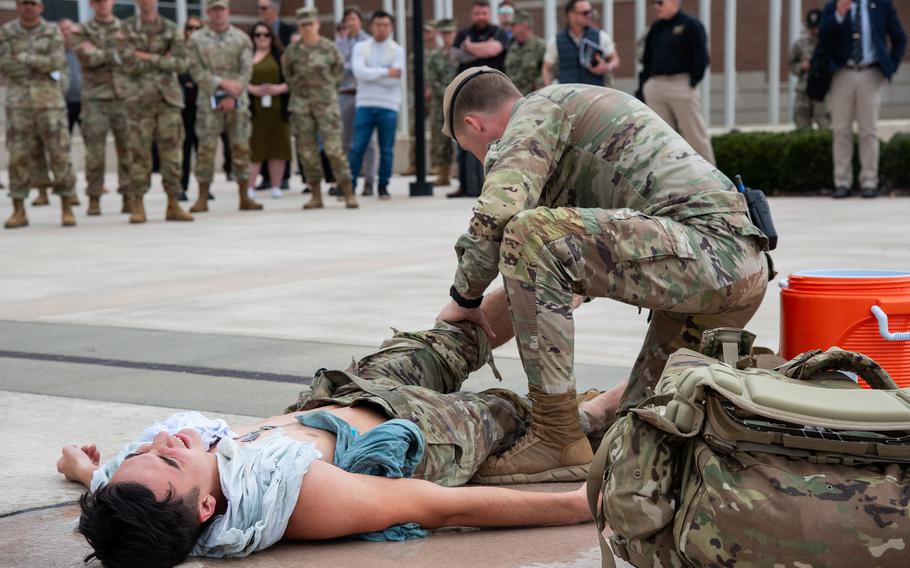
Soldiers with the Army’s 4th Airborne and Ranger Training Brigade demonstrate ice sheeting to rapidly cool a service member experiencing a suspected heat injury during the Army Heat Forum at Fort Moore, Ga., on Wednesday, Feb. 28, 2024. ((Corey Dickstein/Stars and Stripes))
FORT MOORE, Ga. — A small device that soldiers can wear under their uniforms during intense physical activity could be the answer to the military’s decadeslong quest to eliminate severe heat injuries from its ranks, according to Army researchers.
The Heat Injury Prevention System, or HIPS, is a waterproof and wireless device that straps to a soldier’s chest, much like commercially available heart rate monitors some fitness enthusiasts use while exercising, said Mark Buller, a research physiologist with the U.S. Army Research Institute of Environmental Medicine.
But HIPS does more than monitor heart rate — measuring other critical data including skin temperature, estimated core body temperature and the wearer’s movement patterns to predict whether the person is at an elevated risk for a heat injury, Buller said Wednesday during the Army’s annual heat forum at Fort Moore.
“We can predict 25 out of 30 heat cases, including heat strokes” using HIPS, he said. That gives leaders a new ability to adjust training on the fly if they see their troops are overheating or to stop one trainee from completing an exercise before he or she becomes ill, according to Buller.
Wearables such as HIPS will likely prove to be lifesavers, said Lt. Col. Dave DeGroot, who leads the Army Heat Center, a Fort Moore institution that researches heat, its impact on troops and examines how to prevent serious injury such as heatstroke.
While HIPS remains under development, DeGroot believes it is ready for large-scale adoption in the Army.
As the world grows hotter, DeGroot said the Army needs as many tools as possible to train soldiers safely in the heat — especially at initial entry training locations such as Fort Moore, where most of the Defense Department’s heat injuries occur among new trainees unaccustomed to military operations.
“The bottom line is heatstroke is 100% preventable,” DeGroot said. “Mild [heat injuries] are going to occur. If they don’t, I would question the quality of the training, but heat stroke doesn’t have to happen. That is our goal. And we’re trying to provide all the tools that can help us get there.”
Heat forum
DeGroot has run the Heat Center since it was founded in 2018 — making it his life’s work to reduce heat injuries in the Army and work toward eliminating heatstroke injuries. Each year, he hosts the Army heat forum to bring experts together to provide Army commanders and officials with the latest heat injury prevention and response information.
Fort Moore — located in hot, swampy southwest Georgia — has long seen the highest heat injury rates among all Defense Department installations worldwide. The post accounted for some 16.7% of U.S. military heat injuries from 2018 to 2022, with about 2,075. But its rates fell in each of those years, at least in part because Fort Moore leaders bought into heat injury prevention efforts, including conducting the most strenuous training during the coolest parts of days and use of a preventative method called arm immersion cooling to reduce soldiers’ core body temperatures while operating in the field.

Basic trainees with E-Troop, 5th Squadron, 15th Cavalry Regiment, 194th Armored Brigade participate in the Thunder Run on June 29, 2023, at Fort Moore, Ga. The Thunder Run requires Armor recruits on their first day of training to work under time pressure to find the fastest, most efficient way to move an assortment of equipment by carrying it at a run along a quarter-mile track, handing off to teammates at four points along the way, then setting the items down at the end in the same way they were arranged. (Patrick A. Albright/U.S. Army)
After those years of steady decline, however, Fort Moore saw its heatstroke rate shoot up last year amid the hottest summer in recorded history. Heatstroke is the most serious form of heat injury in which a victim typically experiences a core body temperature above 104 degrees and can lead to organ damage, seizures and death, according to the Army.
DeGroot said Fort Moore had 55 heat strokes in 2023, up from the installation’s all-time low of 35 in 2022. More than 20 of the heat strokes occurred just in July, he said.
While the higher temperatures were certainly a factor in more heat strokes last year, DeGroot said they do not alone explain the increase.
Officials at Fort Moore speak with every heat injury victim at the installation to study the issue and help leaders avoid more injuries. Leaders at the installation have adopted several changes in recent years to help curb heatstroke incidents.
Soldiers in initial entrance training conduct arm immersion cooling — dunking their arms in ice water to lower body temperature by one degree — at breaks during training on warm days. They also practice ice sheeting before training events, which is the practice of placing frozen bed sheets on a victim who is already suffering a heat injury to cool them as quickly as possible in the field. At Fort Moore, drill sergeants are trained to ice sheet anyone suspected of suffering even a minor heat injury.
Col. Ryan Wylie, the chief of staff of Fort Moore’s Maneuver Center of Excellence, said leaders overseeing the center’s training for recruits, officers and the airborne and Ranger schools have been empowered to make decisions to avoid heat injuries. He urged leaders to look carefully at weather conditions especially during major training events such as ruck marches with heavy loads, long runs or daytime land navigation courses, which see the most heat injuries at Fort Moore. Each year, more than 100,000 soldiers train in Fort Moore’s basic training and initial training for infantry and armor soldiers. Thousands of additional soldiers serve temporary assignments at the installation to train in dozens of other courses, including Ranger School, Airborne School and the Sniper Course.
“We’ve got to be able to evaluate risk in the middle of an event and make a decision to stop,” said Wylie, who previously commanded a training brigade at Fort Moore. “I’ve seen that in a couple of different cases where we have an event [such as] … a 10-mile foot march, where units have seen a significant number of heat injuries and decide to continue to train.”
Instead, Wylie said, it would be “great decision-making” to shut down the event until conditions are better to avoid heat injuries.

Competitors race toward the finish line of a ruck march during the MSNG Best Warrior Competition at Camp Shelby Joint Forces Training Center, Miss., on March 22, 2023. (Shawn Keeton/U.S. Army National Guard)
HIPS
DeGroot said a system such as HIPS could help leaders make such decisions in real time before losing several soldiers to heat injuries.
With HIPS, the chest-strapped sensor sends a wireless signal to a phone monitored by a leader, such as a drill sergeant. The phone can display the sensors’ readings of dozens of troops at once — showing each service member in green if they’re unimpacted by heat, in yellow if they are at a heightened risk, and in red if they appear to be experiencing a heat incident.
Buller, the research physiologist, said the device is best used for “high-risk events,” such as the long marches with heavy packs and timed runs that basic trainees must complete to become soldiers. While he has worked with other wearable devices, including smart watches, Buller said only the HIPS has proven itself accurate enough and rugged enough to withstand military training.
Since 2018, Buller and other researchers have captured data from more than 14,000 Army and Marine trainees using HIPS primarily at Fort Moore and at the Marine Corps Recruit Depot at Parris Island, S.C., he said.
Researchers tested HIPS at Parris Island in the summer as Marine recruits completed the final recruit training exercise known as The Crucible. Buller said the Marines saw a reduction in heat strokes in summer Crucibles while recruits wore HIPS last year compared to previous years. Only one recruit experienced a heat stroke in 2023, compared with six in 2021 and three in 2022.
The Marines’ Training and Education Command has ordered HIPS to become a regular part of its training, Buller said.
DeGroot urged senior Army leaders to make the same decision.
“This has great potential,” he said. “If we can get unit-level leaders this access to real-time data, they suddenly don’t have to worry about all these other factors, they have the ability for heat illness mitigation right there. That’s something potentially great.”

Soldiers with the Army’s 4th Airborne and Ranger Training Brigade demonstrate ice sheeting to rapidly cool a service member experiencing a suspected heat injury during the Army Heat Forum at Fort Moore, Ga., on Wednesday, Feb. 28, 2024. (Corey Dickstein/Stars and Stripes)